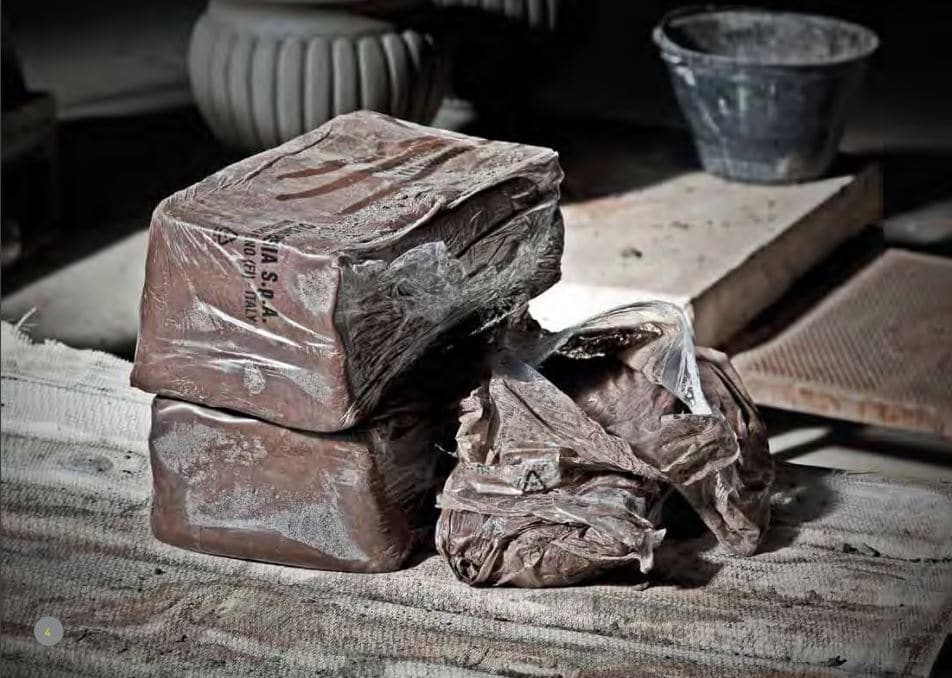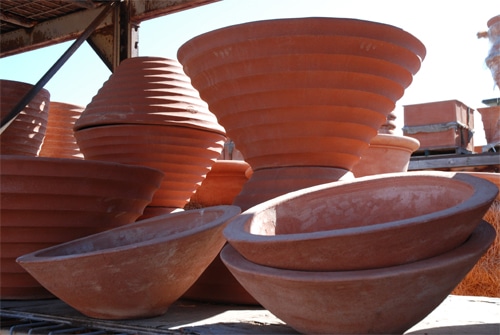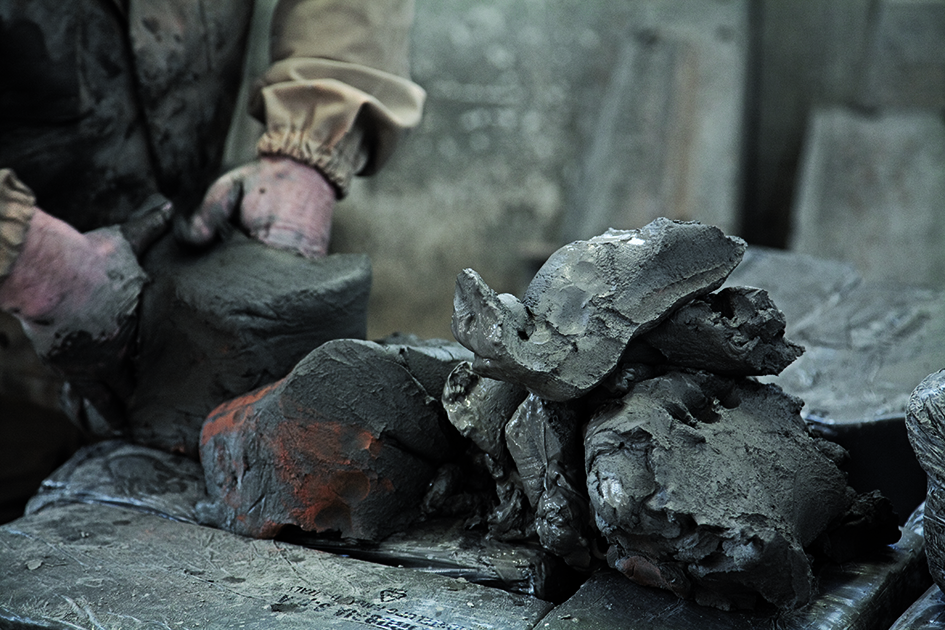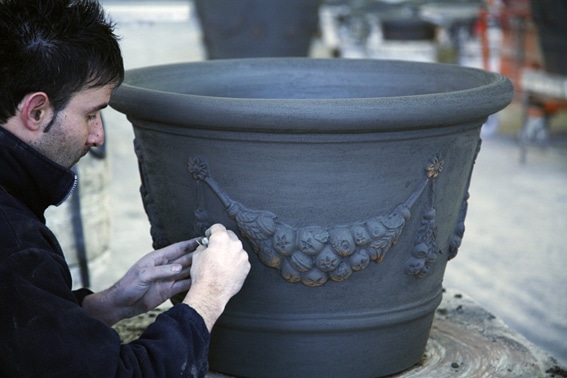Frostproof Terracotta Pottery – A Worthwhile Investment
You have just designed a garden in an area where it snows and freezes, and the temperature goes from freeze to thaw, freeze to thaw for weeks and months on end. You are putting the finishing touches to the project with garden art you chose, approved by your client and they ask you if the pots are frostproof and if they will last through the winter. Should they be removed, stored away from the elements? Or, your design incorporates many containers on the client’s patio next to their pool and overlooking the golf course in Palm Desert, California. They want to know if the pots will crack on a hot day if splashed with cold pool or hose water. Are you comfortable with the quality of the product you have specified?
Just as specifying high quality plant material is important for your designs, so is choosing durable pottery that will last. It’s important to provide a strong, stable container that will support the plants as well as withstand replanting for years to come.
The difficulty and expense of handling large planters in and out of the landscape is another reason to more closely consider your selection. There are other frost proof materials such as metal and stone. However, for our purposes we are discussing and defining terracotta clay pots and containers, specifically made using the quality Italian clay known as Galestro. Galestro’s most famous iteration is known as Impruneta clay because it is used by the historic artisans of the commune of Impruneta long known for their pottery. The clay is found throughout the Tuscan region and its high mineral content gives it its strength and makes it frost resistant.

For over 35,000 years man has taken clay from the earth, shaped it and baked it in fire to produce ceramics for art, function and protection. There are places where fire isn’t even used, instead the sun bakes the clay into a harder form. The quality of the clay and the temperature at which it is fired determines the longevity of the end product. Our Italian terracotta products, made with Galestro clay and fired in a kiln are considered earthenware. If you were to rate the hardness or porosity of earthenware on a scale of one to ten, our frost proof terracotta would be a four and porcelain eight. Our Gladding McBean pottery is stoneware and is also frost proof. Its resistance to freezing is even higher than Italian clay.
I like to tell clients that the Wrigley Building in Chicago, which was completed in 1921 is covered in the same clay tiles that our Gladding McBean pottery is made from today. The original Wrigley tiles have withstood freezing temperatures to minus 50 degrees for almost a hundred years. Talk about frost resistant! If you are interested in learning more about clay and pottery check out Erik Painter’s Quora thread on “What is the difference between stoneware and earthenware clay? How is each used and made?”
The most important thing for our clients, whether they are retail customers or professional designers, is that both our Italian terracotta manufacturers and Gladding McBean continue to create products that are frost proof using clay and processes that are not just frost resistant, but long lasting too. I’m often amazed by terracotta pottery from elsewhere in Italy, Asia or Mexico and how fast it deteriorates—even in Southern California climates. There are individuals who like to see the terracotta flaking or spalling because they see it as aged and patinaed. This is usually around the top edge of the pot but also can happen lower down the side of the pots where water leaches through the clay and begins to break it down. If there is freeze when this is happening the clay will expand and then contract causing the flaking and breakdown of the pottery to accelerate. If you like this look, then purchase terracotta pots which are not frost proof.
For clients living in areas which experience freeze and freezing temperatures for extended periods of time, it is necessary to remove containers to a covered, dry area or building or run the risk that their investment won’t last more than a year or two. Even if you remove the plant material and bag the pots, any remaining moisture in the pores of the containers will cause damage in freezing climates. Fifteen years ago, when I was in France I noticed that the garden centers were selling pottery from China and Malaysia. There were lots of colorful choices and of course the price had the local gardeners snapping them up. A couple of years later I didn’t see as many, so I asked my French friend why not and he told me, “They don’t last more than a year or two, they fall apart.” This non-frost resistant pottery is colorful and priced well below most handmade pottery that is frost proof. However, if you look at the cost of a quality pot that last decades, even centuries, you will not be just money ahead (or your heirs will) you will have the satisfaction of watching your containers patina and age into beautiful artifacts for your garden.
“But I don’t live in a cold climate, why do I need pottery that is frost proof”, you ask? Well, because it is the quality that you are buying. If Italian terracotta pottery is frost proof, it is high quality and that quality in climates like Santa Barbara will last even longer but more importantly in the near term it will look and outperform any other clay products you might choose.
Frost proof terracotta will last longer in the heat of the desert? Yes! The quality and strength of this product will withstand the desert heat. When pots get super-heated from the sun they absorb water quickly and expand and crack. Our terracotta will not do this; just the way they stand up to frost they stand up to heat because of their high porosity.
Winterize Your Terracotta Pots
While our Italian terracotta is super strong, has a high porosity (meaning tight pores, less permeable) and doesn’t absorb moisture like inferior clay, it still must be cared for in the winter time. The following are some tips for making your investment last:
- Put pots on wooden feet away from the ground so the frozen earth cannot fuse to the pot, expand and crack it.
- Ensure that the pot drains well and will not retain moisture which may find its way into it during the frost season.
- Further guarantee that the pot is covered and sealed from allowing rain or snow into it.
- Remember the warranty is to minus 15 degrees so if you feel there will be extremes beyond this to take precautions which will further protect them from moisture.

Like anything, a good dose of common sense will go a long way so pay attention to planting all containers with plant material that have aggressive root balls i.e. giant birds of paradise, agaves etc.
The case for purchasing quality terracotta pottery is that if it is of the highest quality it should be of clay that is fired at temperatures that ensure that it is frost and heat proof and will last for many years. To prove this point, I would like to offer the following argument: If you have ever seen many of the ruins in Rome, you might have noticed the remaining terracotta tiles that make up the massive walls. Most of these structures were built a more than a thousand years B.C. and they still exist today. Their quality and longevity prove my point. Thanks for your time. Brent








Leave a Reply